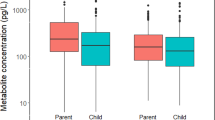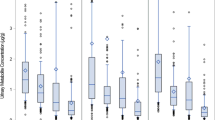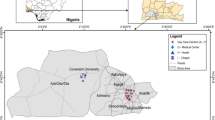Abstract
The Minnesota Children's Pesticide Exposure Study (MNCPES) provides exposure, environmental, and biologic data relating to multipathway exposures of children for four primary pesticides (chlorpyrifos, malathion, diazinon, and atrazine), 14 secondary pesticides, and 13 polynuclear aromatic hydrocarbons (PAHs). Monitoring was performed on a probability-based sample of 102 children aged 3–12 in Minneapolis/St. Paul and in a nearby rural area (Goodhue and Rice counties). This paper provides estimated distributions of this population's exposures and exposure-related measurements and examines associations among the various measures via rank (Spearman) correlations. In addition, it provides some aggregate and cumulative exposure estimates for pesticides, and compares the relative intakes from inhalation and dietary ingestion. Intakes for the four primary pesticides appeared to come principally from the ingestion rather than the inhalation route; this was clearly true for chlorpyrifos but was less certain for the other three primary pesticides because of their higher degree of nondetects. Solid food rather than beverages was clearly the main contributor to the ingestion intake. Despite the dominance of the ingestion route, the urinary metabolite of chlorpyrifos exhibited a stronger association with the air measurements than with the dietary measures. Personal-air samples exhibited strong rank correlations with indoor air samples for chlorpyrifos, malathion, and diazinon (0.81, 0.51, and 0.62, respectively), while personal-air atrazine levels correlated well with outdoor levels (0.69); personal-air diazinon levels also correlated well with outdoor levels (0.67). For the PAHs, many significant associations were evident among the various air samples and for the air samples with the dust samples, especially for those compounds with consistently high percent measurable values (particularly fluoranthene, phenanthrene, and pyrene).
This is a preview of subscription content, access via your institution
Access options
Subscribe to this journal
Receive 6 print issues and online access
$259.00 per year
only $43.17 per issue
Buy this article
- Purchase on Springer Link
- Instant access to full article PDF
Prices may be subject to local taxes which are calculated during checkout
Similar content being viewed by others
Notes
A weighted analysis makes use of sampling weights, which reflect the differential selection probabilities of participants. It allows the resultant estimates (e.g., of means or medians or proportions) to apply to the target population, rather than to just the sample of participants, and also allows for standard errors of the estimates to be generated that properly account for the unequal weighting and other features (e.g., stratification, clustering) of the sampling design.
Rank correlations are preferred since they are insensitive to extreme values and do not depend on the particular measurement scale (e.g., concentrations or logarithms of concentrations). The correlation between two measures is not reported if either measure has less than 10% measurable values.
Abbreviations
- BW:
-
body weight
- EPA:
-
US Environmental Protection Agency
- FQPA:
-
Food Quality Protection Act
- MNCPES:
-
Minnesota Children's Pesticide Exposure Study
- NHEXAS:
-
National Human Exposure Assessment Survey
- NRC:
-
National Research Council
- OP:
-
organo-phosphate
- PAH:
-
polynuclear aromatic hydrocarbon
- PAI:
-
partial aggregate intake
- PCI:
-
partial cumulative intake
References
Adgate J.L., Clayton C.A., Quackenboss J.J., Thomas K.W., Whitmore R.W., Pellizzari E.D., Lioy P.J., Shubat P., Q6Stroebel C., Freeman N.C.G., and, Sexton K . Measurement of multi-pollutant and multi-pathway exposures in a probability-based sample of children: practical strategies for effective field studies. J Expos Anal Environ Epidemiol 2000: 10: 650–661.
Feldmann R.J., and, Maibach H.I . Percutaneous penetration of some pesticides and herbicides in man. Toxicol Appl Pharmacol 1974: 28: 126–132.
Gallo M.A., and, Lawryk N.J . Organic phosphorus pesticides. In: Hayes W.J. Jr., and Laws E.R. Jr. (Eds.). Handbook of Pesticide Toxicology. Academic Press, New York, NY, 1991.
Hines C.J., and, Deddens J.A . Determinants of chlorpyrifos exposures and urinary 3,5,6-trichloro-2-pyridinol levels among termiticide applicators. Ann Occup Hyg 2001: 45(4): 309–321.
Pellizzari E., Lioy P.J., Quackenboss J., Whitmore R., Clayton A., Freeman N., Waldman J., Thomas K., Rodes C., and, Wilcosky T . Population-based exposure measurements in EPA Region 5: a Phase I field study in support of the National Human Exposure Assessment Survey. J Expos Anal Environ Epidemiol 1995: 5: 327–358.
Pellizzari E.D., Smith D.J., Clayton C.A., and, Quackenboss J.J . An assessment of data quality for the Q7NHEXAS — Part II: Minnesota Children's Pesticide Exposure Study (MNCPES). J Expos Anal Environ Epidemiol 2002, submitted.
Quackenboss J.J., Pellizzari E.D., Shubat P., Whitmore R.W., Adgate J.L., Thomas K.W., Freeman N.C.G., Stroebel C., Lioy P.J., Clayton C.A., and, Sexton K . Design strategy for assessing multi-pathway exposure for children: the Minnesota Children's Pesticide Exposure Study (MNCPES). J Expos Anal Environ Epidemiol 2000: 10: 145–158.
Sexton K., Kleffman D.E., and, Callahan M.A . An introduction to the National Human Exposure Assessment Survey and related Phase I field studies. J Expos Anal Environ Epidemiol 1995: 5: 229–232.
U.S. Environmental Protection Agency. Exposure Factors Handbook: Vol. I, General Factors. EPA/600/P-95/002Fa. August 1997.
Wester R.C., Sedik L., Melendres J., Logan F., Maibach H.I., and, Russell I . Percutaneous absorption of diazinon in humans. Food Chem Toxicol 1993: 31(8): 569–572.
Acknowledgements
We gratefully acknowledge the adroit technical assistance of K. Thomas, L. Cauble, M. Hermann, and L. Klemm for sample collection; of the Center for Disease Control for metabolite analysis in urine; of the Environmental and Occupational Health Sciences Institute for pesticide analysis in dust samples; and of numerous personnel at Research Triangle Institute. This effort was supported by University of Minnesota Subgrant No. Q6626127101 and EPA Cooperative Agreement No. CR821902-01-0. Although the research depicted in this article has been funded by the EPA, it has not been subjected to review and therefore does not necessarily reflect the views of the agency and no official endorsement should be inferred.
Author information
Authors and Affiliations
Corresponding author
Rights and permissions
About this article
Cite this article
Andrew Clayton, C., Pellizzari, E., Whitmore, R. et al. Distributions, associations, and partial aggregate exposure of pesticides and polynuclear aromatic hydrocarbons in the Minnesota Children's Pesticide Exposure Study (MNCPES). J Expo Sci Environ Epidemiol 13, 100–111 (2003). https://doi.org/10.1038/sj.jea.7500261
Received:
Accepted:
Published:
Issue Date:
DOI: https://doi.org/10.1038/sj.jea.7500261
Keywords
This article is cited by
-
Respiratory, hepatic, renal, and hematological disorders among adolescent females environmentally exposed to pesticides, Menoufia governorate, Egypt
Environmental Science and Pollution Research (2022)
-
Opportunities for evaluating chemical exposures and child health in the United States: the Environmental influences on Child Health Outcomes (ECHO) Program
Journal of Exposure Science & Environmental Epidemiology (2020)
-
Diazinon, an organophosphate pesticide, induces oxidative stress and genotoxicity in cells deriving from large intestine
Environmental Science and Pollution Research (2016)
-
Human exposures to PAHs: an eastern United States pilot study
Environmental Monitoring and Assessment (2013)
-
Using exposure biomarkers in children to compare between-child and within-child variance and calculate correlations among siblings for multiple environmental chemicals
Journal of Exposure Science & Environmental Epidemiology (2012)



